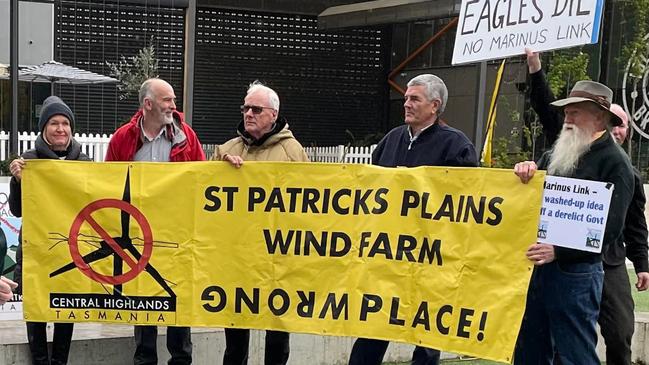State government says that Tasmania needs more renewable energy despite public opposition to wind farm projects
The Tasmanian government is pushing to double renewable energy generation by 2040, but certain projects have received considerable public backlash. These are the most divisive projects.

Tasmania
Don't miss out on the headlines from Tasmania. Followed categories will be added to My News.
The much-delayed Robbins Island wind farm proposal, which has been in the works for decades, is exhibit A for the state’s divide around renewable energy projects.
In fact, you could go as far back as the Franklin Dam controversy of the 70s and 80s as proof of the public opposition to renewable energy.
Wind power makes up 17 per cent of Tasmania’s total energy, and the state government wants to double renewable energy generation by 2040.
However, the last wind farm in the state came online in December 2020.
While Energy and Renewables Minister Nick Duigan said several projects in the planning process would be operational by the end of the decade, there is no timeline for when the next proponent will have its power generation venture fully commissioned.
With its operators saying it was “perfectly positioned to take advantage of Tasmania’s excellent wind resource”, Granville Harbour Wind Farm is the state’s most recent.
“The wind farm has previously hit the number one spot and is regularly in the top 10 performing wind farms in the National Electricity Market when looking at the monthly capacity factor,” a spokesperson from the wind farm said.
“We have a fantastic team on-site and enjoy being part of the West Coast community.
“To date, the wind farm has generated 1300 GWh, enough electricity to power 150,000 Tasmanian homes for a year.”

Like the Robbins Island wind farm before it, a proposed project at St Patricks Plains in Tasmania’s Central Highlands has attracted fierce opposition.
The local council recently approved the project after it had been greenlighted, with conditions from the Tasmanian Environmental Protection Authority.
The No Turbine Action Group formed in opposition to the St Patricks Plains Wind Farm.
However, its president, David Ridley, said the group was not anti-development or against all wind farm projects.
“We, as a group, have recognised that there’s other areas they can go to, and we’ve suggested that to the wind farm company when it started off,” Mr Ridley said.
“But they didn’t even look at the others.
“We support the nearby Cattle Hill Wind Farm - which is only seven kilometres away - because it’s in the right spot.
“But we don’t support the St Patricks Plains Wind Farm because it’s in the wrong spot.”

Mr Duigan said renewable energy projects were vital for Tasmania to maintain power demand.
“Tasmania’s legislated Tasmanian Renewable Energy Target to double on island renewable generation by 2040 sets the foundation for what needs to be done - whether that is organic growth through electrifying our homes and businesses, our existing major industrials wanting to expand, or new industries setting up shop here,” he said.
“The fact is, we need more renewable energy on the island.”
Mr Duigan said the Liberals “took a strong energy agenda” to the recent state election, which resulted in the party forming a minority government.
“We recently removed barriers that were preventing Hydro from partnering and investing in new renewable energy generation, and we have progressed our plan to streamline the approvals with a dedicated approvals pathway which assists the continuing rollout of major renewable energy projects.
“The Renewable Energy Approval Pathway will provide a pathway for projects, such as wind farms and transmission lines, through the Major Projects Assessment Process.
“Two large-scale projects, Whaleback Ridge and North East Wind, are currently undergoing assessment under our Major Projects approval pathway.”
Mr Duigan said that any renewable energy development was subject to rigorous and independent assessments and that public consultation was essential to that process.
More Coverage
Originally published as State government says that Tasmania needs more renewable energy despite public opposition to wind farm projects




